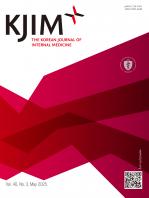|
Nephrology / Original Article
CTLA4-Ig protects tacrolimus-induced oxidative stress via inhibiting the AKT/FOXO3 signaling pathway in rats
Long Jin, Nan Shen, Xinyu Wen, Weidong Wang, Sun Woo Lim, Chul Woo Yang
Korean J Intern Med. 2023;38(3):393-405. Published online April 28, 2023
Background/Aims: Although the conversion from tacrolimus (TAC) to cytotoxic T-lymphocyte-associated antigen 4-immunoglobulin (CTLA4-Ig) is effective in reducing TAC-induced nephrotoxicity, it remains unclear whether CTLA4-Ig has a direct effect on TAC-induced renal injury. In this study, we evaluate..
|
|
|
Nephrology / Original Article
Assessment of nephrotoxicity of herbal medicine containing aristolochic acid in mice
Yi Quan, Long Jin, Kang Luo, Jian Jin, Sun Woo Lim, Yoo Jin Shin, Eun Jeong Ko, Byung Ha Chung, Chul Woo Yang
Korean J Intern Med. 2020;35(2):400-407. Published online November 21, 2019
Background/Aims: It is undetermined if herbal medicines (HM) containing aristolochic acid (AA)-containing have similar nephrotoxicity to AA itself.
Methods: We administered HM containing a high concentration of AA for 5 days (short-term study) or a low concentration of AA for 30 days (long-term stu..
|
|
|
Nephrology / Original Article
The effects of addition of coenzyme Q10 to metformin on sirolimus-induced diabetes mellitus
In O Sun, Long Jin, Jian Jin, Sun Woo Lim, Byung Ha Chung, Chul Woo Yang
Korean J Intern Med. 2019;34(2):365-374. Published online December 13, 2017
Background/Aims: This study was performed to determine whether adding coenzyme Q10 (CoQ10) to metformin (MET) has a beneficial effect as a treatment for sirolimus (SRL)-induced diabetes mellitus (DM).
Methods: DM was induced in rats by daily treatment with SRL (0.3 mg/kg, subc..
|
|
|
Nephrology / Original Article
Effects of metformin on hyperglycemia in an experimental model of tacrolimus- and sirolimus-induced diabetic rats
Jian Jin, Sun Woo Lim, Long Jin, Ji Hyun Yu, Hyun Seon Kim, Byung Ha Chung, Chul Woo Yang
Korean J Intern Med. 2017;32(2):314-322. Published online September 30, 2016
Background/Aims: Metformin (MET) is a first-line drug for type 2 diabetes mellitus (DM); its effect on new-onset diabetes after transplantation caused by immunosuppressant therapy is unclear. We compared the effects of MET on DM caused by tacrolimus (TAC) or sirolimus (SRL).
Methods: DM was induced..
|
|
|
Nephrology / Review
Role of dipeptidyl peptidase-4 inhibitors in new-onset diabetes after transplantation
Sun Woo Lim, Ji Zhe Jin, Long Jin, Jian Jin, Can Li
Korean J Intern Med. 2015;30(6):759-770. Published online October 30, 2015
Despite strict pre- and post-transplantation screening, the incidence of new-onset diabetes after transplantation (NODAT) remains as high as 60%. This complication affects the risk of cardiovascular events and patient and graft survival rates. Thus, reducing the impact of NODAT could improve overall..
|
|
|
















